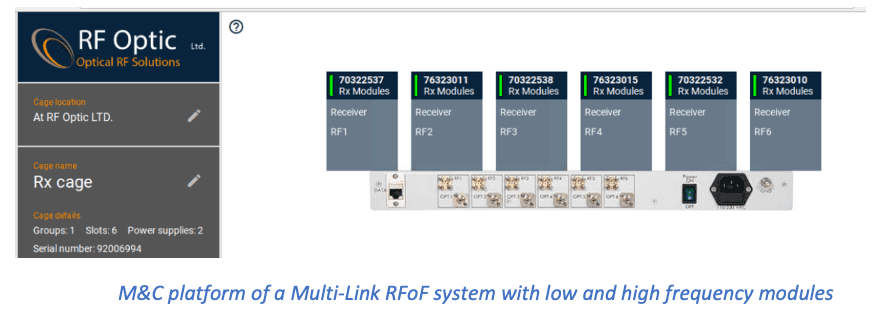
RFoF Connector Challenge
07/21/2022
MWC Las Vegas 2022 – Las Vegas Convention Center, Las Vegas, NV SEPTEMBER 28 – 30, 2022
09/21/2022RFOptic's RF Over Fiber (RFoF) solutions are split into two categories. RFoF solutions can also be referred as RF Over Glass (RFoG) or RF (Radio frequency) to Fiber Converters
- Programmable Low Frequency RFoF links
- High SFDR High Frequency RFoF links
The Low Frequency RFoF links use Direct Modulated laser and support from 0.5 MHz up to 6 GHz. They are programmable because the RFoF link’s S21 system link gain can be adjusted through the GUI if needed. The additional management and monitoring capabilities are described in the user manual. Each module is light, about 150 grams, and compact, 2.75”x 2.75” and 0.9” in height. They come in 5 different versions as detailed https://rfoptic.com/low-freq-rf-over-fiber/
The High Frequency links use Mach-Zehnder modulation and also support from 0.5 MHz up to 40 GHz. They are designed to provide High Spurious Free Dynamic Range (SFDR). Considering the very large frequency band supported the modules are still relatively light and compact. They come in 5 various versions that support various frequency bands as detailed https://rfoptic.com/hsfdr-freq-rf-over-fiber-2/
One M&C Platform for all RFoF modules
Both the Low Frequency and High Frequency modules can be managed through the same RFOptic Management and Control (M&C) platform and housed in the same chassis or ODU (outdoor enclosure). This architecture enables cost effective multi-channel deployments as the customer can purchase the RFoF modules that only support the frequency range needed.

While the Ethernet based HTML/SNMP M&C is optional and only available for the modules that are housed in the RFOptic chassis or the ODU, API and USB based local M&C platform is standard and available for all RFoF modules. API and SNMP enable the users to integrate the RFoF modules into their own M&C platform. MIB is provided.
Power Efficient Design
6 GHz RFoF Tx module with the internal 30 dB Low Noise Amplifier (LNA) turned on draws less than 0.4 A at +5 VDC generating only 2-Watt power. This allows these modules to be used in RFOptic’s or customers’ own enclosures without any special cooling requirement. Even the High Frequency RFoF modules are very power efficient. The Q0 version of the 40 GHz Rx and Tx modules consume only 0.5 Watt and 2.5 Watt respectively
Durable Design
RFOptic's RFoF modules are designed with durability and sturdiness in mind. The Mean Time Between Failures (MTBF) for all the modules is 300,000 hours. Further, the modules do not require any calibration or maintenance
Performance
Each manufactured RFoF link goes through Acceptance Testing and an Acceptance Test Report (ATR) is prepared to compare RF and Optical specifications against the published specs or against agreed upon specs for custom designs
Laser Customization
The default wavelength used on the low frequency RFoF links up to 6 GHz is 1310 nanometer while it is 1550 nm for the High Frequency models up to 40 GHz. However, the RFoF modules can be customized with any 13XX and 15XX WDM (Wavelength Division Multiplexing) lasers. Since multiple optical signals each with a different wavelength can be transported through the same fiber, custom lasers are sometimes required in muti-channel deployments. Further, in cases when long distance transport is required, the low frequency RFoF modules are usually custom fitted with 1550 nm lasers which have a lower optical loss per kilometer (km) than the 1310 nm lasers

